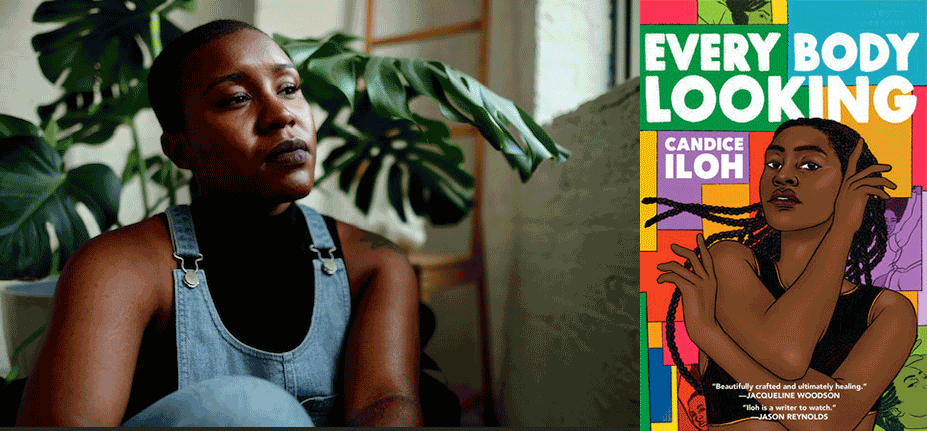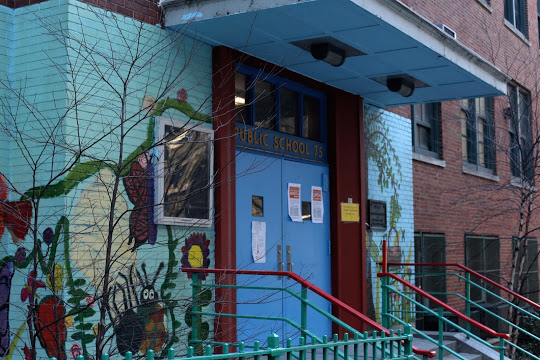Candice Iloh is a first-generation Nigerian-American writer, performer, and facilitator. Her debut novel, Every Body Looking (Penguin Random House, September 2020), tells the story of Ada—daughter of an immigrant father and an African American mother—and her struggle to find a place for herself in America and in her own family. Visit Penguin Random House Classroom site to learn more and for classroom resources that can be used with the book.
In all my teaching with kids I focus on identity because I think it’s a good springboard for everything else. I’ve always loved using the poem “Afro Latina” by Elizabeth Acevedo when talking about identity. I’ve worked with a lot of kids who are Black and who speak Spanish at home, and their friends don’t understand how they can be LatinX and also Black. I think a lot of kids identify with this idea of multiple identities, and it can be applicable in a lot of ways, not just being from the African diaspora. It’s a very specific poem but also universal. I think kids also identify with the way she delivers the poem. It doesn’t feel old or stuffy. Acevedo uses a lot of poetic devices, which makes the poem extremely teachable. There are a lot of ways into it. I’ve seen a lot of students have an emotional response to the poem, and I think that’s always a great foundation for writing.
I like starting the lesson with the name origin icebreaker, to begin with something that is easy to access before moving on to the video. I like lessons where I bring in information about kids I’m working with to drive the lessons. It really opens kids up––talking about names they shorten or why they allow others to call them by a nickname or different name. It’s a really easy way to bring personal information or family or cultural information into the room.
Bringing in a poem like this gives students permission to think on various events that formulated who they are.
It’s important to keep in mind that when teaching about identity and culture, you have to find ways to take the temperature of the class to make sure it’s the right kind of activity. Using the name origin icebreaker exercise is sometimes touchy. Some students are not as comfortable talking about where their name came from or sharing things about themselves.
I am very sensitive about doing this lesson and am careful to make it voluntary. I let students know that I would like them to think about the question but that they don’t have to share out loud. I also say: if you don’t know where your name came from, write about that. This gives them more ways to engage with the question.
After the icebreaker, I share the video of the Acevedo poem. I really like to use video poems as a mentor text. It draws kids in who are visual learners or who might be resistant to poetry, in general.
Bringing in a poem like this gives students permission to think on various events that formulated who they are. I’ve used this format for a number of different projects. Students I worked with were able to identify a moment that had an impact on them and were able to tell the story of when this thing happened, how it affected them and how they overcame it.
In particular, I like this lesson plan because it can be used for any kind of creative writing students are working on. There are all kinds of possibilities. You can use it for an essay about identity, home culture, or family. For example, I’ve had the result of this be the beginning of a “defining moment” personal narrative for college applications. I always use something creative like poetry to get students engaged in the writing process of something like an essay that might feel stuffy and hard.
Materials
Chart Paper
Markers
Laptop or Smart Phone OR Promethean Board
Vocab
Free-write: the practice of writing without filter, editing, or concern for specific objective
Singular Language: using words or phrase that reference specific and/or unique experiences
Draft: to prepare a version of
Cultural Reference: the practice of pulling something from a specific tradition/ritual tied to a person’s culture to create meaning
ICE-BREAKER: MY NAME
Ask 10 students to volunteer and answer the question: What is your full name (First, Middle, and Last – say it how it is meant to be pronounced)? Invite 1-2 of those students to share who named them and/or where their name came from (this must be volunteered; some students do not know their name origin and should not be pressured to share). The facilitator will participate and share last.
VIDEO TEXT: AFRO LATINA
Show “Afro Latina” – Elizabeth Acevedo . In the poem, the poet uses singular language and cultural references to chart her journey from self-love to self-hate back to self-love again through her reconnection to what she comes from as an Afro Latina woman whose first language was Spanish. While listening or after the poem, students should write down one specific reference she makes to her unique experience that stuck to their brains or hearts.
Have pieces of labeled chart paper displayed in visible/accessible places in the classroom for students to answer guiding questions using post-it notes once the video ends. Give 1-2 mins for students to post what they wrote down on chart paper at the front of the class before moving into group discussion of the poem.
Guiding Questions for Discussion:
- What immediate different emotions/feelings did you observe in the poets performance?
- What lines made you think of an experience you’ve had growing up?
- What was the shift that the poet went through during the poem (from what to what did she move in regards to how she sees herself and her culture)?
Chart some of the experiences as the class discusses and shares similar experiences or memories that they can recall in detail, making a list for everyone to see and draw from.
DRAFTING EXERCISE:
Students begin to fully flesh out and free-write a draft of their story moments. (Usually I do this lesson after introducing story-mapping as a technique, in which case students can refer to that to begin drafting.)
Ask students to employ literary tools: imagery, sensory detail, moment, singular language, free-write, and draft in their attempts to piece together their memory. Before students officially begin, you may facilitate a brief review of each of the tools that students can reference as well as display each on chart paper around the room.
SHARE
Once students finish drafting their fictional moments, ask for 1-2 volunteers to share what they came up with while the rest of class listens and supports.
CLOSE OUT
Ask students to pull one line from their story draft that uses one of the story tools (imagery, sensory detail, or singular language), share it aloud with the class, and place it on the piece of chart paper it matches with on their way out.
Also in the magazine: “The Braver We Become: An Interview with Elizabeth Acevedo” by Matthew Burgess
Candice Iloh is a first-generation Nigerian American writer and dancer from the Midwest by way of Washington, D.C. and Brooklyn, New York. They are a proud alumna of the Rhode Island Writers Colony and their work has earned fellowships from Lambda Literary, VONA, Kimbilio Fiction and a residency with Hi-ARTS, where they debuted their first one-person show in 2018. Candice became a 2020 National Book Award Finalist and in 2021, a Printz Award Honoree for their debut novel, Every Body Looking. Their sophomore novel, Break This House, released in May 2022.
Photo by Justin Lamar Carter



